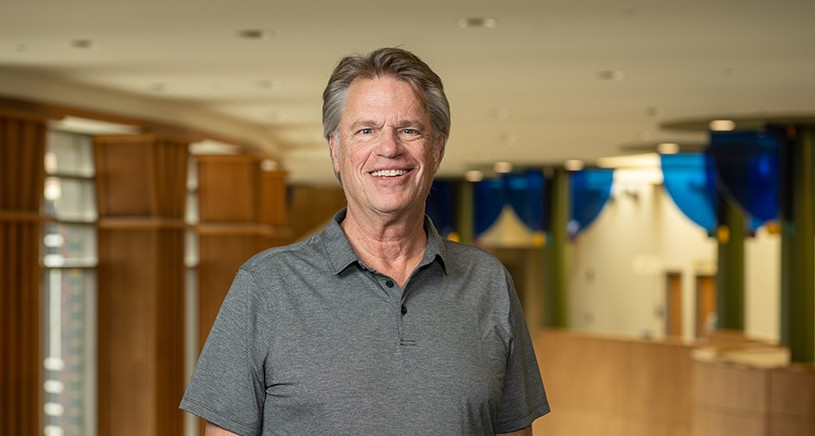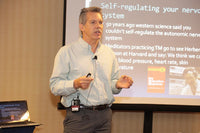
Finding Purpose and Belonging at Work: Part 2
Pictured above: Victor, Strecher, Ph.D, Professor at the University of Michigan
Finding Purpose and Belonging at Work: Part 2
By James Porter
In Part 1 of this blog series, we looked at Dr. Victor Strecher’s research on the connection between purpose and belonging—and how these two qualities can boost employee engagement and well-being. In this second installment, we explore the neuroscience behind these ideas, how purpose rewires our brains, and why the future of wellness may depend on helping people find meaningful connections—both internally and externally.
At the heart of Dr. Strecher’s message is a revolutionary idea: purpose isn’t a luxury at the top of Maslow’s hierarchy—it belongs at the very bottom. It’s the foundation, not the pinnacle. Without a sense of meaning, we falter—physically, emotionally, and cognitively. Dr. Strecher’s team at the University of Michigan has spent years exploring how purpose, especially when aligned with core values, affects brain functioning and behavior.
In one study, participants who were sedentary and wanted to change were split into two groups. One group focused only on learning the skills for behavior change. The second group was asked to reflect deeply on their core values before learning the same skills. The results were striking: the group that connected skills with personal values showed significantly greater reductions in sedentary behavior. Their brains literally functioned differently, with more activation in the prefrontal cortex (PFC)—the area associated with planning, self-control, and decision-making.
The takeaway? Purpose isn’t just motivational—it’s neurological.
And yet, a competing brain structure often gets in the way: the amygdala, the center of fear and threat detection. Through a remarkable MRI experiment, Strecher’s team was able to visualize this in action. Subjects were exposed to anxiety-provoking videos—like a rabid dog lunging toward them—while researchers monitored blood flow to the amygdala. These fear-based responses light up this primitive part of the brain, which is hardwired to react to threats, especially from people or groups perceived as “not like us.”
This evolutionary quirk presents a challenge: as humans, we’re designed to be suspicious of outsiders. But in today’s diverse, interconnected world—especially in the health and wellness fields—we can’t afford to live in fear of “the other.” We must override those instincts and consciously extend empathy and compassion across cultures and communities.
Fortunately, Dr. Strecher believes that cultivating purpose and compassion can quiet the amygdala and engage the more rational, values-driven PFC. This is why interventions like Loving Kindness Meditation can be so powerful. In a conference demonstration, Strecher led the audience in a simple 5-minute exercise, repeating phrases like, “May you be at peace,” and “May you be free from suffering.” Though only a handful of attendees practiced this regularly, the activity prompted reflection on how small acts of connection—even mental ones—can shift our biology and our behavior.
Another example came from a story Strecher told about a subway ride. In a survey of people riding public transportation, those who were asked to think about their purpose before boarding the train reported significantly less fear, loneliness, and distress than those who did not. Again, the data pointed toward the calming, stabilizing power of purposeful thought.
Looking forward, Dr. Strecher coined the term “Well-being 3.0” to describe the next evolution in the health promotion field. This model goes beyond physical health and personal productivity. It focuses on outward-directed purpose—what he calls “outdulgence” (as opposed to indulgence). Instead of incentivizing behavior change with extrinsic motivators—like Health Risk Assessments or wellness points—he suggests using those same resources to let people direct money toward charities they care about. This kind of purpose-driven design not only fosters engagement but can actually extend life: volunteering, for instance, is associated with longer lifespan and better mental health.
In closing, Dr. Strecher reminded us that we are not just brains in a jar. We are meaning-making, relationship-seeking beings. Our brains may light up in fear, but they also light up in love, connection, and purpose. Employers, wellness professionals, and individuals alike should take note: purpose isn’t optional. It’s essential. As Gen Z enters the workforce, with their brains still developing into their early 20s (and women, on average, maturing two years ahead of men), creating systems that foster purpose and belonging will be vital to engagement and resilience in the years ahead.
When we move toward a world where our values align with our actions, where purpose drives policy, and where compassion shapes culture, we don’t just promote health—we redefine well-being.





James Porter
Author